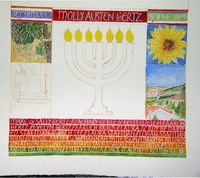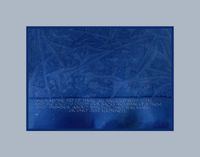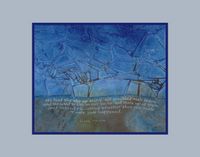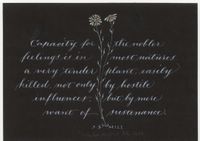
Here’s the first one, which had more problems than the second one.
Pointed Pen 5"x7" Exchange #2
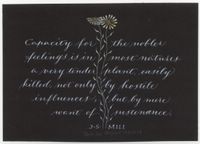
I’m a little late mailing my pieces for an exchange — 3 days, to be exact. Trouble is, I don’t have a whole lot of confidence in my pointed pen skills. And I can’t seem to get through a 5″x7″ piece of paper without running my hand through some wet ink somehow, or pulling a little bit of ink out with the black eraser. Lovely thing, that Factis black eraser!
In the middle of the Molly piece
Click on the thumbnail for a closer look.
Here’s where I am right now on it. And it’s about this point in a piece that I generally wonder whether I’m just masochistic or what. I mean, why decide to do all the lines in frisket? What was I thinking?? It’s like trying to write with a rubber band that keeps stretching and breaking. And the pen has be cleaned every 2 or 3 minutes. But the white lines are the unifying style of the piece, which is what was lacking on the previous 7 attempts.
And then I do the washes and I have to leave the studio to avoid messing with it too soon — I want to see what it “really” looks like with the frisket off.
That actually why I’m posting this right now, to try to avoid put the color on the grapes too soon …
Working draft – the Molly piece
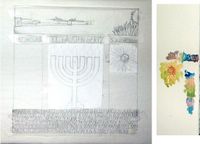
Click on the thumbnail for a closer look.
Well, the end-of-year chores are done, my shoulder is healing nicely, and I’m finally back to working on calligraphy. It’s nice to be back.
I’m currently working on a long overdue gift commemorating a trip made back in summer of 2004. I’ve been working on it all week. I’ve started this piece about 8 times, and always the basic design was too flawed to continue, but now I’ve got something that will work. It will be done tomorrow.
Great article on framing from Jack Thompson
I’ve been away from the computer for a few days, recuperating from shoulder surgery. Although I can’t do art yet, today I was delighted to discover that I can actually surf the Internet again — at least for short periods of time. I came across a great article about framing paper art, by Jack Thompson here.
Broken

The Friday Illustration theme this week is “Broken.” I think this John Stuart Mill quotation is on topic. Before anyone asks, this week it’s not doubling as a bookmark 🙂 … But it could, couldn’t it? Hmmm. The original is about 2″ x 8″, white ink and colored pencils on black charcoal paper. (Click twice to see the scan at full size.)
Tagged
I’ve been tagged by Toni to list 5 little-known facts about myself. I started an artistic response, but I’ve just got too many other projects in the works to finish it. Here are my 5 plain-text facts:
- About 3 years ago my son and I took up playing the accordion. Logan began taking lessons, and because we’d bought a couple of accordions through eBay, I began playing with him. It’s a ridiculously fun activity. Our main influences are a Cajun fiddle player who also plays the concertina and taught at the Suzuki Institute in New Orleans 3 years ago — and Weird Al Yankovic.
- My favorite dog we’ve ever had is a 9-year-old Leonberger named Ponce. (When he was 10 weeks, old, we thought it would be cool to be call him “Ponce the Leonberger.” Haha.) He has bone cancer, and has just beat the vet’s estimate of 2 weeks left to live. I’ll be sad when he’s gone. I’m sad already.
- When I was a teenager I had a chance to tour Europe with an operatic group as their harpsichordist. Instead I went to college to study accounting. Go figure.
- I was in my mid-twenties before I had a clue that there is another kind of lox besides the liquid oxygen that’s used as a propellant in rocket fuel. I grew up in Merritt Island, Florida; NASA takes up the northern part of the island.
- We have a 14-rank pipe organ in our living room. Some people have boats or antique cars. We have unusual musical instruments.
That’s it. If I’d been blogging a little longer, I might know some fellow bloggers I could tag. Maybe in a few months.
Pipe-cleaning chameleon

Here in north Florida, chameleons must have a fatal attraction to my studio. I’m constantly finding that they’ve slipped in, and although I try to help them back out the door, every once in awhile I find that one has come in died of dehydration, I guess. I hate when that happens, so I’m constantly on the lookout for chameleons.
This little creature on my work sink kept catching my eye. A second glance would show it to be the overused and rusted-out pipe cleaner that I use to clean my glass eye droppers. After the 20th double-take, I took a photo of it and then threw it out.

